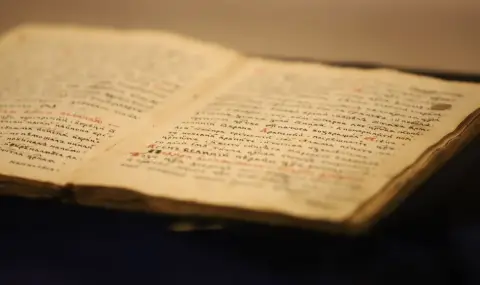On September 13, 1996, the original of “Slavic Bulgarian History&rdquo ; of Paisius Hilendarski was brought by an anonymous donor to the National History Museum. He left the manuscript, wrapped in a newspaper, with the secretary of the director of the museum, Bozhidar Dimitrov.
The very operation of the theft of “Slavic Bulgarian History” is codenamed “Marathon“ and is conducted by Department 14 “Cultural and Historical Intelligence“ of State Security.
The purpose of the operation is to replace the original manuscript with a forgery.
Expertise by the archeographic commission at the National Library “St. St. Cyril and Methodius” confirms that this is the original - an author's copy of Paisius himself, discovered in the Zograf Monastery in 1906 by Prof. Yordan Ivanov. After more than a year of controversy over the fate of the manuscript, in 1997 the President of Bulgaria Petar Stoyanov (1997-2002) and the Ministry of Culture decided to return the manuscript to the Zograf Monastery.
On January 12, 1998, President Petar Stoyanov, Minister of Culture Emma Moskova and Chief Prosecutor Ivan Tatarchev were present at the ceremony of handing over the historical manuscript. The abbot of the Zograf Monastery, Archimandrite Amvrosii, received the manuscript from the director of the National History Museum, Bozhidar Dimitrov. Today “Slavic-Bulgarian History” is kept in the Zograf Monastery in Athos next to the servant of Patriarch Euthymius, the Dragan mineus and other valuable manuscripts, recalls dariknews.bg.
The scandal related to the Zographic transcript of “Slavic Bulgarian History” began in 1991 after the return of the Prime Minister of Bulgaria Dimitar Popov (1990-1991) from a visit to Greece, during which he visited the Bulgarian monastery “ St. Georgi Zograf” in Athos.
In response to his request to the monks of Mount Athos to allow the original of “Slavic Bulgarian History” to be exhibited for worship in Bulgaria, the former boss of the ephoria “Zograph” in Sofia, Petar Mitanov publicly stated that the manuscript of Paisius Hilendarski is located in Bulgaria.
The manuscript was smuggled out of the Bulgarian monastery on the Mount Athos peninsula in 1988
For eight years it was locked in the safe of the head of Bulgarian intelligence.
The very operation of the theft of “Slavic Bulgarian History” is codenamed “Marathon“ and is conducted by Department 14 “Cultural and Historical Intelligence“ of State Security. The purpose of the operation is to replace the original manuscript with a forgery. It was prepared for 10 years from 1972 to 1982. The operation itself was launched in 1982. In December 1984, the intelligence officer Hristo Marinchev went to the Zograf Monastery in Athos, but only reached Thessaloniki, as the Greek authorities refused him access to the peninsula. The legend of the officer is that of the deputy chairman of the Church Affairs Committee of the Bulgarian Orthodox Church, but in fact he is the deputy head of Department 14, responsible for cultural and historical intelligence in Greece and Cyprus.
After the failed attempt in December 1985, the employees of the First General Directorate, legendary as first secretaries in the Bulgarian embassy in Athens, were designated as participants in the operation – Ivan Genev and Ventsislav Again. They are helped by the employee from the embassy in Athens, Dinko Pehlivanov. Again, he took the manuscript out from under his clothes and took it to the Consulate General of Bulgaria in Thessaloniki. From there it was forwarded to the embassy in Athens, from where it ended up in Bulgaria with diplomatic mail.
Pehlivanov's role is that of a so-called “clean man“ who does not suspect the actions of others. He found out about the theft only after leaving the monastery.
On Nicholas Day 1985, Ivan Genev brought the historical manuscript to us.
